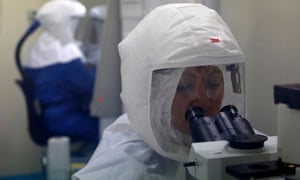
Splitting the atom brought humanity nuclear power and nuclear weapons. A cure for cancer would have the same potential for pushing humanity to new highs – or terrifying lows. According to John Sotos, the chief medical officer of Intel, the same technology which may someday allow us to defeat illness for good also poses the prospect of tailored diseases attacking individuals, families or even whole races and rewriting their genomes on the fly.
Sotos made his remarks at the DEF CON hacking conference in Las Vegas, a place where hackers gather to share tips and tricks for how to break into almost anything with a circuit board. But in a weekend where attacks were demonstrated against wind farms, voting machines and almost every major smartphone in one fell swoop, Sotos’ nightmare scenario still stood out as plausible and terrifying.
The Intel executive, best known publicly for his work as a consultant on the TV show House for six years, argued that the eventual success of Joe Biden’s “cancer moonshot”, a US government-funded programme aiming to find vaccine-based generalisable treatments for cancer, would necessarily open up the potential for bioweapons of unimaginable destructive potential.
“The reason you haven’t heard much about bioweapons is that they’ve been held back by a pretty severe limitation, which is the potential for blowback,” Sotos said. It is hard for any attacker to use weaponised diseases, because they spread beyond their initial distribution range: destroy your neighbouring nation and you destroy your own as well.
But, Sotos argued, “the cancer moonshot is going to really drive new technologies to manipulate DNA, because cancer is a disease of DNA. [And] the same exquisite targeting that allows it to attack only your cancer cells also overcomes the blowback potential for bioweapons.”
In other words: if you can build a treatment that can be restricted to attack only cells with the genetic flag for cancer, you can build a bioweapon that can be restricted to attack only individuals with a particular genetic flag revealing their ancestry, gender or family.
The technology doesn’t exist yet, although a number of medical techniques such as Crispr – a genome-editing tool – show the potential of such biohacking. But Sotos argues that its eventual refinement “is inevitable. There are going to be thousands of people doing this sort of genetic manipulation down in the basements of hospitals.”
But a plausible attack doesn’t just mean mass fatalities. “There’s some stuff worse than dying,” Sotos said, “and I call that hell.”
What, for example, if groups spread their agenda in a very direct way, by literally rewriting DNA to make it impossible to live lives against their credo? Suppose militant vegans wanted to end meat eating: there’s a gene for that. Or radical misogynists wanted to force veiling all women: there’s a gene for sunlight intolerance, and the genetic functions of gender are already well known.
Or, he suggested, attacks could be on an individual level: targeting a public figure by stealing their genetic code, or targeting their whole family by sequencing someone closely related to them, would be possible. And the attacks could be subtler than expected: Sotos cited genes for intractable diarrhea, massive weight gain, total baldness and “an intense fishy body odour”.
But Sotos was suggesting a worst-case scenario, and other scientists criticised him for distracting from real problems in the present. “Creating noise & sounding alarms this way isn’t helpful to saving lives,” tweeted DJ Patil, the former chief data scientist of the US Office of Science and Technology Policy. “The risk is really small. It’s really hard to mass produce these. The real risk we should be focusing on is drug resistant TB and pandemics.”

